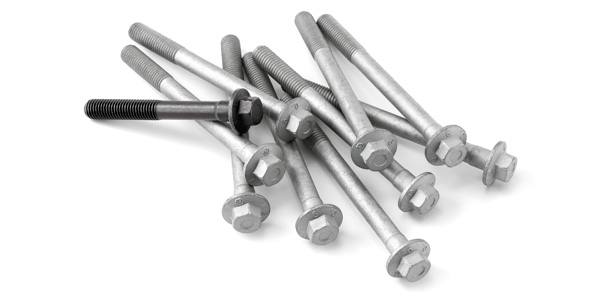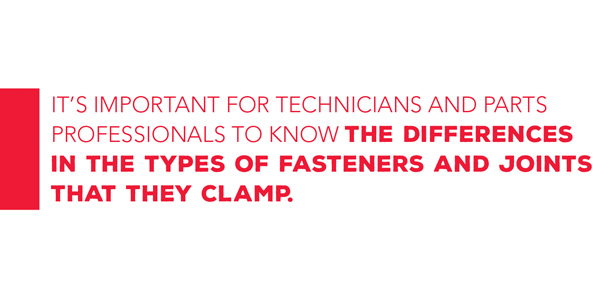
Traditional fasteners are torqued to a load that will slightly stretch the bolt but won’t over-stretch it past its yield point. Torque-to-yield (TTY) fasteners are stretched beyond the point of elongation to ensure a more consistent clamp load on the joint. It’s important for technicians and parts professionals to know the differences in the types of fasteners and joints that they clamp.
TTY fasteners have been the fastener of choice for bi-metal engines, in which two different metals – such as an aluminum head and a cast-iron block – need to be clamped together. The different expansion rates of these two metals make them challenging to seal, because they move at different rates. Therefore, manufacturers came up with a solution to use TTY fasteners along with multi-layer-steel head gaskets to absorb head lift. But there are other uses for TTY fasteners.
Today, TTY fasteners are employed for bolted joints in a variety of automotive components, such as ball joints, knuckles and tie rods. Most of the applications are aluminum. However, TTY fasteners also are used on steel components, because they create a more consistent clamp load on the bolted joint.
A fastener is much like a spring, as it must be stretched to provide clamping force. The higher the preload, the more force is applied through this stretch. About 90 percent of the applied torque is for overcoming friction that’s split between the bearing surface (the area under the head of the bolt or nut) and the threads.
“A common 3/8-inch small-block Chevy rod bolt will generate about 10,000 psi preload when stretched to 0.0055 to 0.0060 inches,” explains Robert Florine, president of ARP Fasteners. “Of course, you simply can’t crank up the preload on any fastener, as factors like material, heat-treat and diameter are at play.”
Rod bolts are one example where it’s possible to measure “stretch” in the bolt because of access to both sides of the fastened joint. But in many cases, the application is in a blind hole, and therefore clamp load is calculated by torque or applied force.

TTY fasteners are engineered to stretch within a controlled yield zone. Once they reach this zone, they’re designed to spring back to provide a more precise level of clamping force. This stretches the bolts into their elastic range, and in some cases, the stretching approaches the bolts’ elastic limit, permanently stretching them.
Once the yield zone is reached, the clamping force will be more consistent. Getting to the precise yield zone (for maximum clamping force) is accomplished by tightening bolts to a specific torque spec, and then turning the bolts an additional number of degrees.
TTY bolts used by the OEMs typically are installed by robotic equipment up to 90 to 120 percent of yield, according to Florine. “This is certainly adequate for a stock application,” he says. “But if the engine is modified to any real extent, you’re asking for trouble.”
Since TTY fasteners are yielded by design, they should not be re-used, Florine says. Once yielded, a fastener’s ability to adequately provide clamping force in a second usage has been compromised. ARP offers high-performance fasteners that are engineered to give a 25-percent to 30-percent safety margin so they can be re-used. But for stock applications, high-performance fasteners may be overkill.
When installing TTY fasteners – especially head bolts – it’s important to follow the proper torque sequence and procedure. Always clean the threads, as thread damage, corrosion or rust will create friction, giving a false torque reading. Clean, oiled threads prevent binding, allowing for accurate and consistent torqueing. Be careful not to over-oil the bolts, especially if they’re threading into a blind hole. Too much oil will hydro-lock the bolt and give false torque readings.





